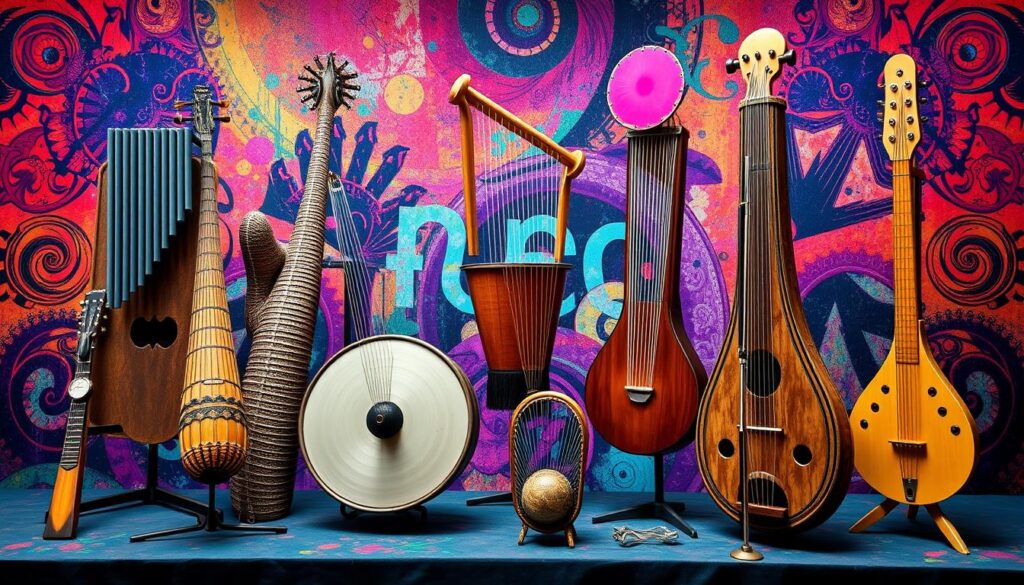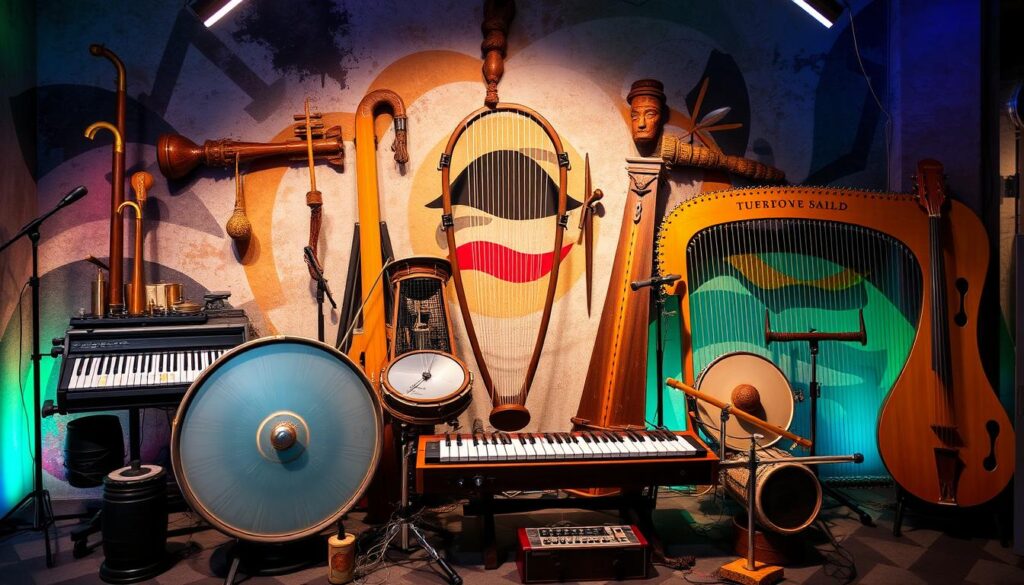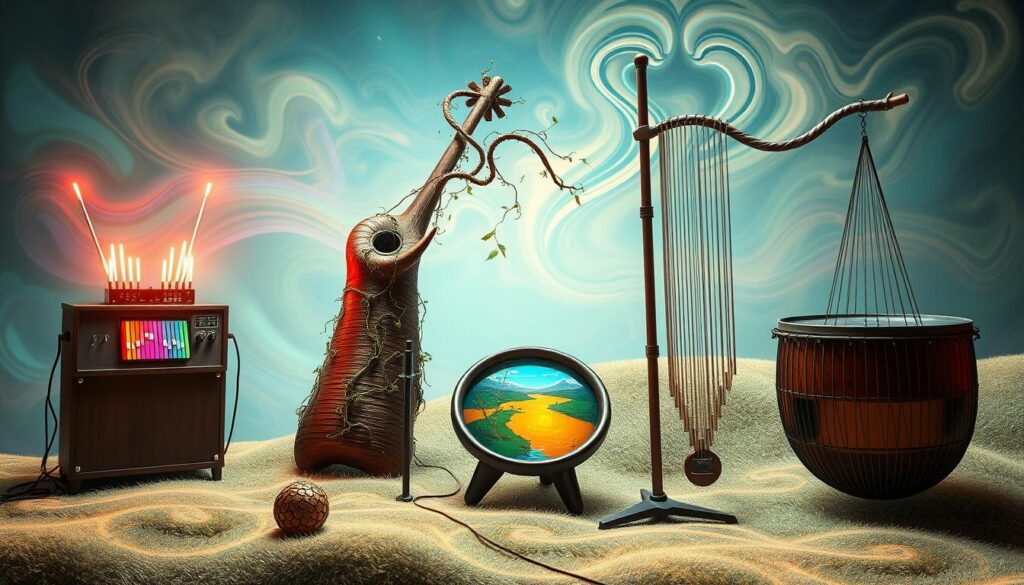
Beyond the Guitar: Exploring the Most Bizarre Instruments in Music History
Music is more than just the guitar. Exploring unusual instruments can be a fun journey. You’ll discover unique sounds and broaden your musical knowledge.
There are over a hundred instruments to explore, like the Baroque guitar and Turkish clarinet. The khaen, a giant harmonica, can make many different sounds. This journey will inspire and intrigue you, making it unforgettable.
Key Takeaways
- Exploring unusual musical instruments can broaden your musical horizons
- There are over a hundred unique instruments to discover, each with its own character and sound
- The khaen is a great example of an unusual instrument that can produce a wide range of tones and sounds
- Going beyond the guitar can introduce you to a world of unique instruments in music
- Unusual musical instruments can inspire and intrigue you, making your musical journey more exciting
- Beyond the guitar: exploring the most bizarre instruments in music history is a fascinating journey that awaits you
The Evolution of Musical Innovation Through Time
Exploring music reveals a variety of strange tools and devices that have shaped the industry. From ancient times to now, musical innovation has evolved significantly. The glass harmonica, for example, has been used by artists to make unique sounds.
The history of musical instruments is rich and diverse. Different cultures have contributed to the development of new instruments. The citole and cithara, for instance, have influenced the creation of modern instruments. These ancient instruments show the variety of musical innovation.
Ancient Sound-Making Devices
In ancient times, people used tools like the citole and cithara to make music. These instruments were the start of modern instruments, like the guitar. They have greatly influenced the music world.

The Birth of Experimental Instruments
The theremin is an example of an experimental instrument that has changed music. It lets musicians explore new sounds. This has inspired modern musicians to use unique gear to create music.
Modern Sound Engineering Revolution
Today, technology has led to new instruments and sounds. Musicians can now make music that was once impossible. This revolution has inspired the use of strange tools and devices in modern music.
The Hydraulophone: Making Music with Water
When you dive into the world of rare instruments, you might find the hydraulophone. It’s a special instrument that uses water to make sound. This tool has a history that goes back to ancient times.
The hydraulophone has changed over the years. It now uses new materials and tech. Steve Mann has designed some versions, even using hot tubs for a deeper sound. Musicians can change the water flow to make different sounds. This makes the hydraulophone a standout in the world of music.

Other unusual instruments include the eight-necked electric guitar and the sharpsicord. They challenge what we think of music. The hydraulophone, with its water-based sound, is another creative instrument.
Rare and peculiar instruments in music keep surprising and exciting us. The hydraulophone is a great example of music’s endless possibilities. It shows how creativity and innovation can come together in music.
Glass Harmonica: Benjamin Franklin’s Musical Innovation
As you explore music beyond the guitar, you’ll find unique instruments that have changed music history. The glass harmonica, created by Benjamin Franklin in 1761, is one such instrument. It has a series of glass bowls or goblets of different sizes, placed side by side on an iron rod.
In the 18th century, the glass harmonica became very popular. Famous composers like Mozart and Beethoven used it in their music. Its sound, made by running wet fingers around the glass bowls, amazed people and led to new music.
Construction and Design Principles
The glass harmonica lets musicians play up to ten notes or chords at once. This is thanks to its special design with glass bowls arranged in a circle. This instrument was a wonder of its time, with its haunting sound moving people and sparking creativity.

Notable Compositions and Performances
The glass harmonica first appeared in 1762 and quickly became a key part of European music. It remained popular for many years, with many famous composers and musicians showing off its unique sound. Exploring unusual musical instruments, you’ll see the glass harmonica as a symbol of music’s innovation and creativity.
The Theremin: Playing Music Without Touch
The theremin is a unique instrument in music that you play without touching it. It uses electronic signals to make sound. Lev Theremin invented it, making it the first electronic instrument to succeed.
To play the theremin, you move your hands in an electromagnetic field. This makes it a strange musical tool that needs precise hand movements.
The theremin can make many different tones and volumes. This makes it great for many music styles. Musicians like Dorit Chrysler say it’s very expressive, changing sound with just a little movement.
Theremins have two antennae: one for changing the pitch and the other for changing the volume. Playing the theremin well takes skill in moving your fingers and hands. Famous players include Clara Rockmore and Samuel Hoffman, who used it in TV and movies.

The theremin has a long history, first shown in 1920. It’s been used in many kinds of music, from classical to pop. You can learn more about it and even try playing one to hear its unique sound.
The Zeusaphone: Lightning-Powered Musical Tesla Coils
Exploring exotic music devices, you might find the Zeusaphone. It uses lightning-powered Tesla coils to make sound. This gear is used in many music styles, from classical to electronic.
The Tesla coil was invented by Nikola Tesla in 1871. It boosts electricity to high voltages, creating a mesmerizing sound. Usually, it can play two notes at once, adding excitement to any show.
Artists like Terry Blake and Jeff Larson have made their own Tesla coil designs. Their work is popular at conventions and among “coilers” – those who build and play with Tesla coils. The Zeusaphone offers a thrilling experience with its unique sounds.
The Zeusaphone’s sound is captivating and haunting. It’s perfect for those wanting to try new sounds. Its rich history and unique sound make it a favorite among musicians and music fans.
The Great Stalacpipe Organ: Nature’s Underground Symphony
When you dive into the world of rare instruments in music, you’ll find the Great Stalacpipe Organ. It uses stalactites to make sound, giving a natural and enchanting musical experience. This instrument is a prime example of peculiar musical instruments used in many musical styles, from classical to ambient.
The story and making of the Great Stalacpipe Organ are quite interesting. Its use in different music genres shows its flexibility. You can hear its sounds in underground caves or concert halls. It’s a great example of how nature can inspire music.
The Great Stalacpipe Organ can create a variety of tones and has a unique way of making sound. Its sound is often called ethereal and haunting. This makes it a favorite for musicians wanting to create a magical atmosphere. If you love music or just want to see something unique, the Great Stalacpipe Organ is worth checking out.
Beyond the Guitar: Exploring the Most Bizarre Instruments in Music History Today
Music goes beyond the usual instruments. The world of unusual musical instruments is vast and exciting. Innovators keep exploring new sounds and creativity.
Recently, digital technology has changed music. Musicians now use software and hardware to make unique sounds. This has led to new instruments like the Waterphone and the Hang.
These instruments make new and interesting sounds. Today, composers and performers are using these unusual musical instruments. They are creating a new and innovative musical world.
Digital Integration with Unusual Instruments
Some musicians use sensors and electronic tools to create sounds. This mix of traditional and electronic music makes a rich soundscape. It keeps growing and changing.
Contemporary Composers and Performers
Today, many composers and performers are exploring new sounds. They use beyond the guitar: exploring the most bizarre instruments in music history. They are making music more vibrant and dynamic.
By using digital tools and unusual instruments, they are changing music. They inspire others to explore new sounds and techniques.
The Singing Ringing Tree: Architecture Meets Music
Exploring unique instruments in music leads to the Singing Ringing Tree. It’s a blend of architecture and music. Located in Lancashire, England, it’s a hit with tourists. It shows how art, music, and nature come together.
The tree’s design is a marvel of human creativity. It’s made of metal pipes tuned to sound when the wind blows. This tool is a prime example of how strange instruments can make beautiful music. Walking around, you hear different sounds from the pipes, making for a unique experience.
Design and Construction
Architects Mike Tonkin and Anna Liu designed the Singing Ringing Tree. They aimed to create a structure that interacts with its environment and makes sound. The tree’s look is inspired by the natural surroundings, with metal pipes mimicking tree branches. It’s built with sustainable materials, making it eco-friendly.
Environmental Impact on Sound
The Singing Ringing Tree shows how the environment affects its sound. The wind is key in creating its unique tones. As it blows, it makes the pipes vibrate, producing various sounds. This instrument is a great example of how nature can influence music.
The Pyrophone: The Explosive Art of Fire Organs
The Pyrophone was invented by Georges Frédéric Eugène Kastner in 1870. It’s a unique music device that uses fire to make sound. This uncommon musical gear offers a dramatic and captivating musical experience.
It has its roots in modern experimental music. The Pyrophone has been used in many genres, from classical to electronic music. The largest Pyrophone, the Pyrophone Juggernaut, stands ten meters high and 12 meters wide. It shows the instrument’s great size and power.
Some key features of the Pyrophone are:
- It can make a wide range of sounds, from soft whispers to loud explosions.
- It uses fire to create sound, making it a truly unique instrument.
- It can be used in many musical genres, from classical to electronic music.
The Pyrophone shows the innovative and experimental side of music. It pushes the limits of what’s possible with uncommon musical gear and exotic music devices. Exploring unusual instruments can open up new sounds and experiences. It can change how you see music and art.
Contemporary Experimental Instrument Makers
Exploring rare instruments in music, you’ll find a world of innovators and artisans. They’re making unique musical instruments that change how we see sound and music. New materials and technologies are helping them redefine music for us.
Some top innovators are using new materials and methods to make custom instruments. For instance, instrument makers are using 3D printing to create shapes and structures that were once impossible. This has opened up new sounds and timbres, expanding music’s possibilities.
Custom instrument workshops are also popping up worldwide. They let musicians work with makers to create special instruments. These workshops bring musicians and makers together, sparking creativity and community.
Future Directions in Instrument Design
As technology advances, we’ll see even more innovative instruments. Artificial intelligence and machine learning are leading to interactive and responsive instruments. This is an exciting time for music, with rare and peculiar instruments becoming more available and affordable.
The Impact of Bizarre Instruments on Modern Music
Exploring music beyond the guitar opens up a world of unusual instruments. These instruments have changed the sound of many genres, from classical to pop and electronic. They have created new musical landscapes, pushing the limits of what’s possible.
Many musicians have been influenced by these instruments. For instance, the harpejji, invented in 2007, has been used by several artists. Other instruments like the Glissonic glissotar and the Seaboard have also led to innovative music. The AlphaSphere and the Eigenharp are examples of unusual instruments in electronic music.
Some notable examples of unusual instruments include:
- The Pikasso guitar, featuring four necks and 42 strings
- The Sevena, a seven-necked guitar created by Boredoms
- The laser drum cage, used by Kraftwerk in the 1970s
- The Dube, a percussion instrument invented by Dion Dublin in 2010
The effect of these instruments on modern music is clear. They’ve inspired new sounds and styles. As you explore music beyond the guitar, you’ll find more unusual instruments shaping today’s music. These instruments allow musicians to create something unique and innovative, taking music to new heights.
Conclusion: The Endless Possibilities of Musical Innovation
As we wrap up our look at the most unique instruments in music, it’s clear that musical innovation knows no bounds. From the water-powered strange musical tools of the hydraulophone to the Zeusaphone’s lightning-fueled tunes, the sky’s the limit for new sounds.
The instruments we’ve seen don’t just break new ground; they also make us think differently about music. They show us that the world can be a playground for sound, where even common things can become musical instruments.
With technology getting better all the time, the future of music looks even brighter. We’re seeing digital tools meet unusual instruments, more custom workshops, and innovative makers pushing the limits. This all hints at a future where today’s unique instruments in music and strange musical tools could become the norm.
So, as you explore, stay alert to all the amazing things yet to come. Who knows what incredible sounds will be created by human creativity and ingenuity?